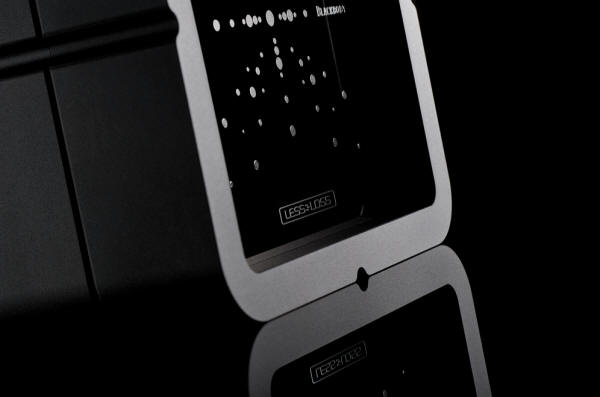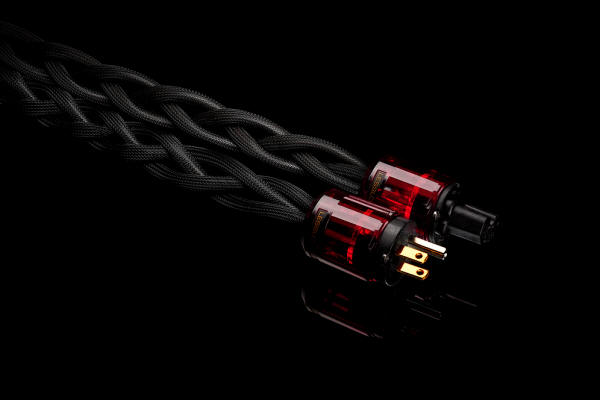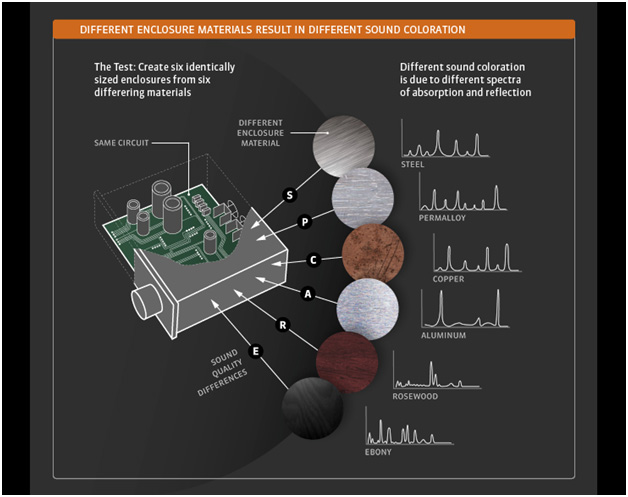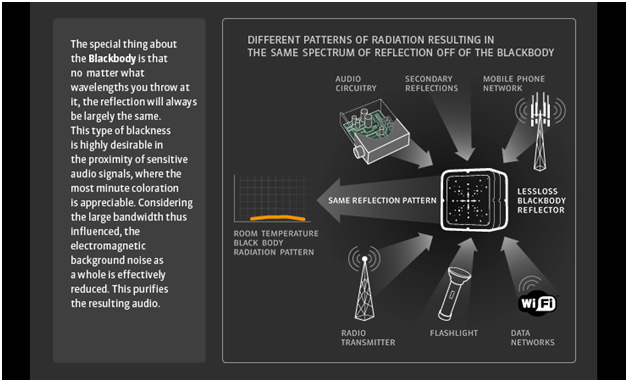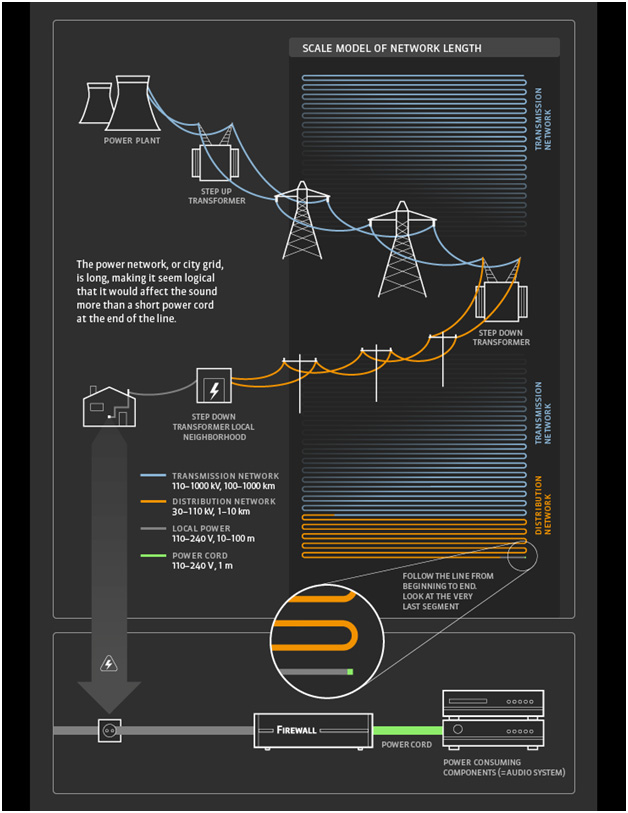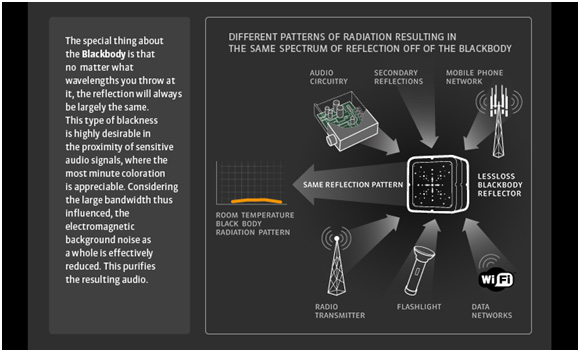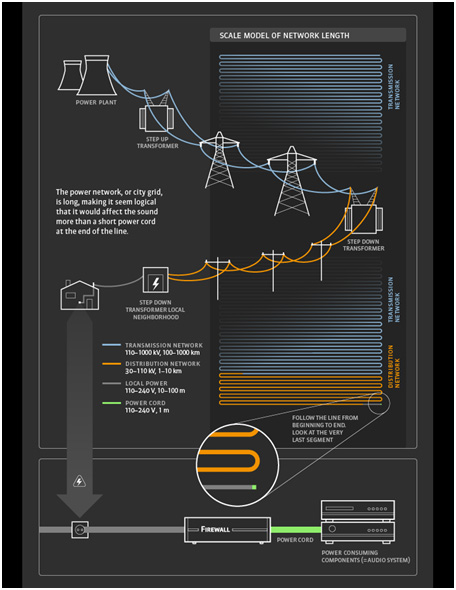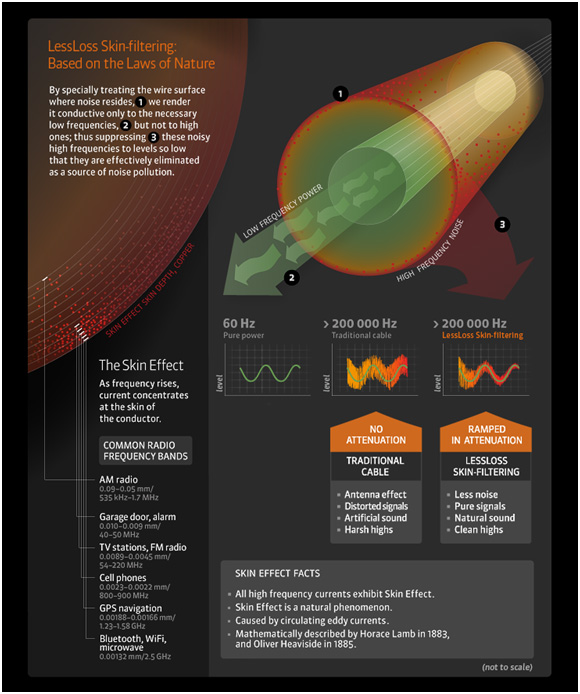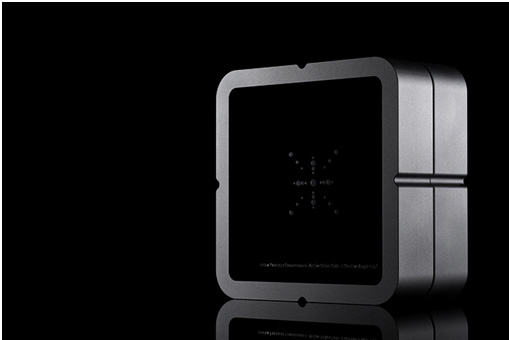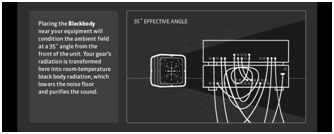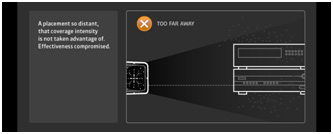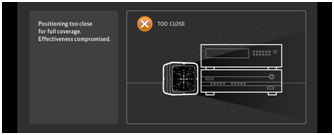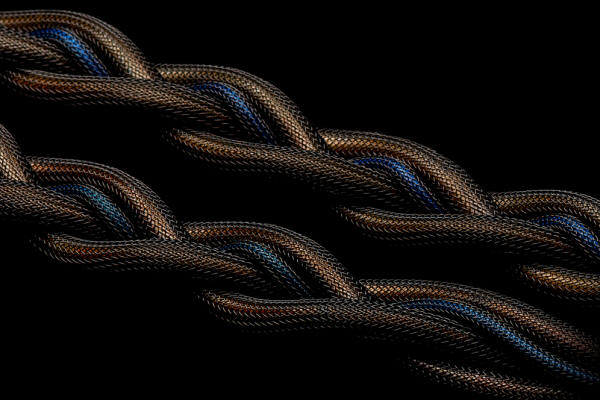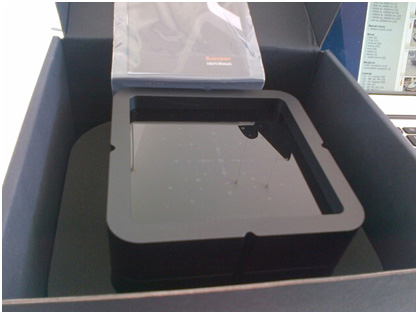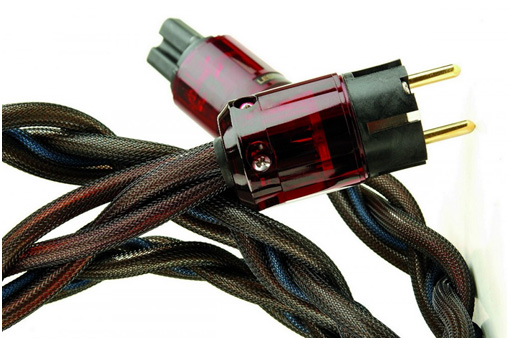|
You are reading the older HTML site
Positive Feedback ISSUE 67
At the Kipnis Studios (KSS)™: LessLoss Blackbody Ambient Field
Conditioners and Dynamic Filtering Power Cables
LessLoss Blackbody Ambient Field Conditioner
Introduction A long time ago, in the spring of 1983, the very first CD player ever marketed, the SONY CDP-101, was delivered to my friend and neighbor, Ed Foster, for testing and evaluation. Ed was one of two people at High Fidelity and (as it turns out—their sister publication) Audio Magazine whose job it was to test and document all aspects of the equipment under review; it turned out that he would be receiving a new version of each and every new CD player that was about to come out in this fledgling digital market. Fortunately, he was happy to let my father and I borrow a unit or two, as they became available to him—for our 2nd opinions of both the sound and operating performance. Naturally, we borrowed and integrated the new SONY into one of two review systems, and listened to a stack of early CD pressings; mostly classical, but a few examples of Rock, Pop, Country, and Soundtracks, were thrown in too. And in comparison to our analog sources, which included LP, LaserDisc, R2R, and Cassette Tapes, the new CD format uniformly sounded more dynamic, more explosive, and more vibrant, with quieter backgrounds than the identical LP albums we had on hand. But there was a penalty for this clean and immediate digital sound; grain and a certain gritty quality to the entire presentation, which made everything sound both brighter and harsher, by comparison. There was also a collapse of the soundstage to just behind the line of the speakers; so no real sense of imaging was apparent, even in well known and established cases, such as the DECCA (London) recording of Sir George Solti and the London Symphony Orchestra. These sounded flat and dimensionless in direct comparisons to the same recording on different analog mediums. After several years of borrowing and comparing one Compact Disc player to another (and to the equivalent commercially available LPs), CD sound was gradually beginning to take on a more spatial and tonally accurate sense of presentation; thanks in part to the use of oversampling filters, better analog output components, improved transport mechanisms and clamps, and even the very first outboard Digital-to-Analog Converters (DACs); making it possible to isolate the digital components from any analog ones, nearly completely. During this era, I had my audio equipment in a 48" tall rolling equipment rack, with each component on its own isolated shelf; cradled on some early Steve Sim's black NAVCOM vibration absorbing pucks (in sets of four). What I had discovered in the preceding few years (since 1980) was the importance of using the BEST possible cables we could afford to get our hands on. And the effect of the length of those cables became both a costly issue, and an important sonic lesson. Because of this, I evolved my component layout to connect everything together via the shortest possible lengths; some interconnects were a mere ½ meter long, running out the back of the rack; mostly Monster Cable M1 & M1000, but also some AudioQuest, Straight Wire, Kimber, and Van Den Hul would make appearances at times. What became clear was a condition that was first identified in the late 1980s as "Electromagnetic Backwash," wherein the location of audio components, like a preamp, CD & LD players, DACs, R2R, and cassette, directly contaminate the audio being switched, processed, and amplified by other components. Digital devices are worse than analog only components in this respect. Thus, stacking a CD player directly on top of a preamp or receiver invariably causes the sound of the whole system to get worse and to gain in musically unrelated distortion while losing all the characteristics associated with good high-end playback, including sound staging and micro dynamics. Unquestionably, audio (and video) components send out (or spew) a whole soup of RFI & EMI components that are easily picked up by other audio (and video) components; all analog components are especially vulnerable since they inherently switch and amplify analog signals that are minute in voltage and/or current. With 1/2 meter cables in particular, I was able to reliably hear this added distortion, much more easily than with longer cables, which seemed to smear or jumble the audio presentation (see my Report on the Skogrand Cables for more on the audio effects of cables on recording and playback gear). So, there was plenty of evidence, way back, pointing toward a clear trade-off between near field component proximity and direct EM interplay, resulting in audio degradation. Just like a table top radio, each and every component (it turns out) also acts as an antenna by drawing in and amplifying certain ambient electromagnetic (EM) fields generated by other components, radio stations, TV transmitters, garage door openers, and now cell phones, etc. And digital components (since they contain both analog and digital audio circuits in close proximity) must be engineered in such a way as to screen and separate any analog from any digital circuits; even down and back to the AC transformers. So unless you purchased an extremely over engineered DAC, digital receiver, preamp, or amp with heavy all copper chassis, EMF mesh screens on every section, and separate power supplies for every section of a circuit (plus individual regulation), you would just have to live with "digititis" while listening to non-analog sources. For me, this meant spending more money on engineering and isolation from the ground up; I was fond of SONY high-end ES (Espirit) CD players and transport/DACs beginning with the 608-ESD, and extending to the R1/DAS-1, as well as certain Pioneer LaserDisc players with heavy copper chassis, like the LD-S1 & S2. And you might imagine that analog video components operate in the same Megahertz frequency band as digital audio; so those devices also interfere and contaminate each other's performance, as well. All in all, a very mixed bag sonically; such was the first 10 years of commercial digital audio, in particular. The reason for this is that energy can neither be created nor destroyed, but it can be modulated to send and receive signals (the basis of all our electronic communications). When this is done digitally, the high frequency switching of the binary signal is represented by analog square waves. Undesired remnants and 'echoes' of these impulses can easily travel from one component we use to enjoy high-end media playback to another. They and other switching noise (from refrigerators, washers, dryers, dimmers, etc.) can come from sources inside and outside our own home; they hitch a ride on the incoming AC power, entering from your wall socket, and contaminate your audio (or video) with low level noise and distortion. So if your neighbors are all listening to their CD players, and watching their TVs, or using their computers to surf the Internet, noise generated by those devices feeds back into the AC power, affecting everyone using the same line, including your local neighborhood, within a few miles of your home. The effect of all this RFI / EMI noise coming from within and without your audio system has been shown to adversely modulate the music signal, resulting in (for each different album auditioned and played): 1) Flattening of the soundstage dimensions 2) Inclusion of grain and noise that causes a "glassy" sound 3) Compression of dynamics through raising the noise floor 4) Listener fatigue due to inharmonic distortions But... the problem of RFI & EMI is further compounded by even more electro-Magnetic and electro-Static interactions; occurring even between the materials of the equipment rack, the carpet, even the furniture present in the listening room; beyond the usual acoustic contribution that any object has in a highly defined listening environment! Perhaps you've heard the effects which certain objects have when they are in the proximity of your audio gear; even the gear orientation itself (even when it wasn't digital). From Louis Motek at LessLoss: Something's Been Missing All power filters and conditioners address noise found on wires, but there's another type of noise altogether. until now, this inconspicuous type of noise has been largely unacknowledged. It is caused by constant electromagnetic interaction between gear and immediately surrounding objects: stands, racks, nearby signal wiring, enclosures, and other objects containing circuitry or not. This type of radiated EM noise is not confined to wires. The Blackbody works by absorbing these reflections, effectively solving the problem. Being the only conditioner of its kind, it offers a level of performance previously unattainable.
AV equipment is created using a wide range of chassis materials; each type affecting sound quality in different ways. EM Radiation is the Cause EM radiation is energy with electrical and magnetic properties that travels in waves. These waves are produced by moving charged particles. Since all things are made up of charged particles, every object radiates EM energy (unless at absolute-zero temperature). Matter also selectively absorbs and reflects EM energy, and each material's EM absorption and reflection pattern is distinct. All matter has its own fingerprint, a type of pattern called a spectral signature of radiation. These patterns are so distinct, scientists can identify the elements of nature from these unique spectral radiation patterns alone. Even the atmospheric composition of distant planets reveal themselves in this way. Quite simply, different materials proximate to your circuitry will affect that circuitry. Your component enclosures, equipment rack, scattered CD collection and all other objects in the room—including the air surrounding your circuitry—are active participants in the shared EM ecosystem. In this mutual network of interaction, the EM radiation emanating from your gear interacts with all other objects' absorption and reflection patterns in a complex fashion, much like the echo and diffusion of sound waves from various objects in a church, only much more quickly, to the point of occurring practically instantaneously.
The Blackbody acts to absorb different spectra of EMI / RFI equally well; reflecting back only a tiny fraction of the energy impinging on it. The Solution The Blackbody is unlike any other filter or conditioner: by absorbing any EM wavelength and by radiating none in our visible bandwidth, the device is as black as black can be; you might even say it is blacker than black, since it'd be the absence of light radiation altogether. Our version of the blackbody is not wired to gear and contains no batteries or power supply; instead, within the device is a special reflector whose emission pattern approaches that of the ideal blackbody radiator. By creating this near perfect blackbody, we've created a device that, simply by being placed in your gear's ambient EM field, will absorb virtually any EM radiation at that location. There, gear will no longer be able to bounce EM radiation off proximate objects, only to have it return to influence its delicate signals and degrade sound quality. The Blackbody's EM radiation pattern lacks a distinct spectral signature, making it impossible for its own radiation to cause sound coloration.
Power contamination comes from a variety of sources (refrigerator, television, computer, etc.) from both inside and outside your home. High Frequency noise enters your AV gear through the wall AC outlet. It is therefore possible to filter it out, using a DFPC power cord. High frequency signals, extending far into the multi-gigahertz range, permeate our atmosphere every day and many have not yet come to adequately appreciate the profound effect such noise has on the listening experience. Because it is indeed inconsequential to the audio gear's lower realms of mere purpose-built functionality ("hey, it plays..."), HF noise is allowed to circumvent gear-internal filtering circuitry through capacitive and inductive coupling. Detrimental effects are widespread as HF noise causes distortion via haphazard intermodulation throughout the gear's circuitry. Without proper filtering, significant signal degradation is inevitable. HF signals naturally attenuate along wires (the "Skin" Effect), making HF noise on the power line most intense the closer it is induced to your gear. So, any means employed to prevent HF noise from entering your gear will be most effective closest to the gear's IEC inlet. The DFPC Power Cord therefore occupies the most critical location to condition power for higher quality audio purposes.
High Frequency noise is eliminated through "Ramped Attenuation"; a natural result of the "Skin Effect" which occurs in solid core conductors. The Product(s) 1) Five (5) LessLoss - Blackbody Ambient Field Conditioners ($1323):
2) Five (5) LessLoss – DFPC Dynamic Filtering Power Cables ($1149)
These two different technologies (as well as others made by LessLoss, including their Firewall Power Conditioners) are expressly designed to absorb, deflect, and prevent EMI, RFI, and ESI from entering (or re-entering) your audio & video components; thereby allowing them to function with the least amount of noise and induced distortion, possible. The specifications from the manufacturer Blackbody
The Blackbody's effective angle is 35° outward from its front side. For optimal performance, use the outer boundaries of this angle as a sort of virtual cone to be placed as tightly as possible around as much component circuitry as possible.
Placement diagram for the LessLoss BlackBody Ambient Field Conditioner This is not your typical "talisman" tweak. Such tweaks are accompanied by diminishing returns once coloration sets in. The Blackbody, on the other hand, is the only object that removes the influence of near-field EM reflections. It lowers the system's noise floor, yet at the same time does nothing to color the sound.
http://www.lessloss.com/blackbody-p-200.html DFPC Power Cables
(1) If you're using exclusively DFPC Originals or exclusively DFPC Signatures, apply them to your system's components in the following order. (2) If you're using at least one DFPC Signature, and the rest are DFPC Originals, first apply the Signature(s) in the following order, and then apply the DFPC Original(s) to the remaining components. 1st: Source (CD player; DAC; Phono preamplifier) 2nd: Power Amps 3rd: Preamplifier 4th: Power conditioner; regenerators, power distribution units 5th: Phono motor http://www.lessloss.com/dfpc-series-p-213.html Pricing Structure So, what value do you place on an "add-on" component versus buying or upgrading to a better grade of gear? In this case, a Blackbody cost $1323 USD direct from the manufacturer (international freight costs are included in the price), and at that price you obviously should expect some type of audio improvement not offered in mainstream electronics. If you get more than one, it can quickly add up to the cost of a new component. This is a new method of addressing EMI & RFI so depending on your system's susceptibility and its actual resolution; the improvements will vary from system to system. It is safe to say that changing any power cord for any other (in a high resolution system & listening room) will make some kind of difference to the sonic presentation. But when real engineering is featured, you are getting a whole different breed of improvement and a bargain if the improvement is obvious. Thus, at a starting price of $595, the DFPC Power Cord (which includes Oyaide model 079 connectors that retail from $216 - $250 plus shipping) seems fair; ordering 2 cables will give you a 5% discount on both, ordering 3 or more gives you 10% off. Shipping is FREE via UPS, to any country in the world. Considering all this, we are obviously dealing with a very high value to cost proposition. The Review System (at Kipnis Studios – KSS™ & Epiphany Recordings Ltd.): (items in italics are on loan from the manufacturer) DIGITAL-to-ANALOG decoders
PS Audio
PowerWave DAC II (with Bridge Card) DIGITAL SOURCES
Mark Levinson
No. 51 DVD-A Transport ANALOG SOURCES
ELP Laser Turntable (Custom Line-Level Output Cards w/ RIAA Correction)
Melos SHA-Gold
Tube preamp / Headphone Amplifier AMPLIFICATION
Crown - Macro Reference (x2) – Class A Modified SPEAKERS
Symdex
Epsilon 3-Way Loudspeakers (Built in 1993 by
Kevin Voecks and Leeland Wallace in Gloucester, Massachusetts - USA) w/ Subwoofer (self Powered 12"): Cambridge Soundworks (x4) INTERCONNECTS, WIRES & CABLES
Skogrand 421 Markarian Speaker Cables & Interconnects (Balanced &
Unbalanced)
Magic
Hexa Vibration Control Feet - 4 feet (x2) The following depicts my personal experience with the Blackbodies over the course of one year. I did not want to rush publishing my observations because of the novel nature of the matter, and my initial cautious skepticism. I needed to be sure about what I was hearing, as well as be consistent over time. I also needed to make sure I was not suffering under delusion or emotional inclination, as can easily happen in the field of audio, due to the well-known affiliation between one's hearing and the realm of emotions associated with music. Only once I felt enough time had passed, and enough research had been completed, did I consider publishing these findings. At the beginning of June, 2012, I received five Blackbody units and each was packed separately in its own UPS International wrapper. Each contained a box made of corrugated cardboard with a soft foam insert formed to perfectly cradle the Blackbody. Each unit came with a basic use instruction card.
The LessLoss Blackbody in its shipping box (with instruction sheet). This is the first time I had reviewed a passive device intended to affect nearby electromagnetic fields. Certainly, any object will affect the acoustic environment of the listening room to some degree, but these little gems offered something quite different from that. And while it may seem a crazy concept, the Blackbody actually works! And that, from the moment I got them. I set them up as instructed, in my primary 2-channel listening system, except… I intentionally left them in their shipping boxes (so as not to be psychologically influenced by their appearance). They worked as indicated; even without having been unwrapped (I know all too well the power of suggestion, especially when related to the field of audio). I critically listened to their effect on my reference system for over 3 weeks before even unwrapping them; but the effect after unwrapping them was the same. I realize just what this type of testing proved: the rather unspectacular notion that the Blackbody works on account of its operational theory of near field electromagnetic reflection, and nothing more. This is exactly the same reason that your cell phone, or a magnet, are unaffected by a cardboard box. The fields involved in the operation of a cell phone, a magnet, or even the Blackbody, do not "see" the cardboard box any more than our eyes see glass or even the air we are constantly looking "through." Electromagnetic fields permeate our lives, interacting invisibly with each other and with all objects, including our AV (and recording) gear. Its effect on sound and picture quality should be obvious, considering the minute levels of the signals we are reconstructing and how subject they are to added distortion products. Therefore, the moment they were placed within a ½ meter of any gear under audition, the audible difference in performance was both subtle and dramatic. Initially, I placed two units in a crisscross fashion to cover (bathe) the PS Audio PowerWave DAC within the 35-degree inclusive operating angle of the Blackbody units. I also placed one each next to the Crown Macro Reference amplifiers, and then later the Carver VTA-20 tube amps; located within 40 cm of the central transformer and to cover the tubes, as well. Finally, one unit was exclusively devoted to covering my MacBook Pro 17 Laptop, which is serving as the digital audio media server, with the best results achieved with the unit about 25 cm in back of the screen. With the five Blackbody units thus set up, I heard these specific changes to a wide range of familiar audio albums and files, from just about every type of music, on hand: 1) Virtually grain-free presentation 2) Expanded and explosive dynamics with intricate low level details 3) Much more spacious sound staging with more stable and seemingly larger presentation size 4) Increased focus and weight of imaging featuring correct timbral presentation 5) Quieter background leading to a blacker black—perceivably longer reverb tails 6) More visceral and palpable (sound "freed from the confines" of the electronics) Here are some review notes I shared on Facebook during the evaluation period: I received 5 Blackbody units via UPS today. http://www.lessloss.com/blackbody-p-200.html Initially, I simply brought them into my 2-channel listening room (which had been playing for about 8 hours, previously.) I set one up in front of each of the two CROWN Macro Reference amplifiers, about 10 cm directly in front, one under the PS Audio PowerWave DAC II, and the last two on my coffee table, in front of me where I can place or remove my laptop—the music server. In each case, the Blackbody device is passive, and does not contact or get connected to any part of the audio system. Oh, I should also mention... I did NOT unwrap them from their UPS bubble wrapping—so they look like packages, right now. Want to know if anything audibly changed? First Report: 1) Much of the electronic HASH is GONE! Normally, this electronic haze clouds imaging and sound staging, and also causes a fatiguing grunge to be present in the upper midrange and lower treble. It also makes louder sounds WORSE overall! 2) Dynamics (as a whole) are now much wider; that is, the loudest parts playing are noticeably louder while the quieter parts have become softer, presented against a VERY BLACK background, where previously grunge existed before the Blackbody's introduction. 3) The harmonic structure of instruments and the acoustic space itself (as heard in the various recordings I am auditioning) ALL show a NEW (inter)related connection amongst themselves along with a wholeness of sonic presentation WITHIN the hall which was simply NOT AUDIBLE before. With these 3 observations also comes the following reactions: A) I am inclined to turn up the volume several dB because the sense of strain that was present above a certain volume level during playback of known materials is no longer as present. To that end, I can now hear better into the acoustic of the various recordings I'm auditioning because I raised the overall volume, and the presentation suddenly falls into place properly as it would in the actual hall itself—for reference (and so you can try this at home), I am listening here to: HOLST: The Planets (1985) Charles Dutoit / Montreal Symphony Orchestra; London DECCA B) Inner details of the recorded acoustic venue and the placement of individual instruments within that space has become vastly more solid and life-like, tangible and palpable; given the perspective found in the recording, which would place one 12 feet in the air hanging over the conductor's head, but back a few feet! Consequently, the holographic imaging has the orchestra descending both BACK and UP; in the same way as you might see it if you were hanging there, like a camera. C) In spite of hearing this performance many hundreds of times since it came out in 1985 (it's one of my 20 best sounding recordings), I now find myself hearing YET NEW things I have never heard, before. Inner harmonies are now clear during both the most massive and the most silent moments. And the degree to which the soundstage hangs free from the speakers is now PALPABLE and VISCERAL, very much the way the BEST Analog discs and tapes sound! Second Report Let's examine a specific example (now that the Blackbody (x5) Ambient Field Conditioners have been in place for about 4 hours: BACH: B-Minor Mass (Archive Production 415514) John Eliot Gardiner: English Baroque Soloists I first purchased this recording on CD (a 3-Disc Box set, $35) back in 1986, from Tower Records 4th & Broadway store; now a relic of a bygone era. It was a glorious purchase, with the sort of reverence for what was about to happen, BEFORE you actually purchased and played the album. Here, under the initial influence of the LessLoss Blackbody units, I hear the following (after 26 years of listening to this album): 1) There is a clear and precise continuity of rhythm and pacing; and this equates, for me, to the same sensation I experience when listening LIVE! 2) Resonances that naturally occur between musical instruments and the acoustic space(s) they perform in (and are recorded within) have become particularly clear and focused, so that when a soloist performs both they and their instrument stand out as two separate but connected physical objects, out in the soundfield being projected free from the speakers. 3) Wife, Carolina (who has also gravitated to this particular recording and performance, since its birth) is for the very first time NOT singing along with the performance. Why (is she not accompanying the performance)? A) There is a new level of detail present in the playback, which has been completely obscured until now. Bear in mind that the playback speakers and amplifiers are from 1994, and in original condition! B) I can't stop playing this performance, even though I have a library of available music that spans 12 TB and over 400 days of continuous music (much of it that I actually like and listen to, regularly)! C) I switched performances of the same piece (BACH: B-Minor Mass, this time with Johannette Zomer, Véronique Gens, Etc.; Philippe Herreweghe: Collegium Vocale Gent), and... WIFE is still transfixed, and not trying to sing along! Astounding... in my 6 years of marriage, this has never happened with this piece, or these performances! These Blackbody units are unlike anything else in consumer or professional audio. And... they make a consistent and impressive improvement in any well put together high resolution audiophile playback system; not to mention home theater! LessLoss Blackbody Ambient Field Conditioners—they could very easily have been just another brand of snake oil—but they do, in fact, work!!! The REAL challenge comes in explaining, clearly and scientifically, what is going on here. And why Louis Motek is a f***ing genius!!! You are going to have to bear with me as I explore a potentially new and rocky terrain in tweakery (and equipment circuit design)! Third Report Let's consider what is going on in this audio experiment via an understanding of a unique and great sounding 20th Century musical instrument (though some might argue that point) known as the Theremin (and featured in the film, The Day the Earth Stood Still, (uncut studio session takes): The Day The Earth Stood Still (Original Soundtrack) [20th Century Fox Film Scores - B000005LBW] - The Classic Series The Theremin… is an early electronic musical instrument controlled without discernible physical contact from the player. It is named after its Russian inventor, Professor Léon Theremin, who patented the device in 1928. The controlling section usually consists of two metal antennas which sense the position of the player's hands and control oscillators for frequency with one hand, and amplitude (volume) with the other, so it can be played without being touched. The electric signals from the Theremin are amplified and sent to a loudspeaker. The Theremin was used in movie soundtracks such as Miklós Rózsa's Spellbound and The Lost Weekend as well as Bernard Herrmann's The Day the Earth Stood Still, also as the theme tune for the ITV drama Midsummer Murders. This has led to its association with a very eerie sound. Theremins are also used in concert music (especially avant-garde and 20th- and 21st-century new music) and in popular music genres such as rock. Psychedelic rock bands in particular, such as Hawkwind, have often used the Theremin in their work. – from Wikipedia So... hands-free control of an invisible EMF (Electro-Magnetic Field) surrounding the two antenna wands of the instrument—connected to a loudspeaker! Hmmm—do you see where this is going? If hands can make an audible difference interacting with a known EMF field (while playing the Theremin) and one can learn to play that field and produce recognizable music, then why isn't that same EMF field (radiating outward from every AV device) also effecting every other AV device in one's Hi-Fi System (or Home Theater)? What about the EMF coming from a cell phone or tablet's Wi-Fi? And from radio, TV, and cell towers? EMF pollution is what makes typical audio reproduction sound like a Hi-Fi (read: artificial audio reproduction)! Most audio equipment (even the best) is subject to noise coming from the many interacting EMF of all varieties, frequencies, and amplitudes, present in our daily lives; even the EMF interactions between the Earth and the Sun (which itself has a regular heartbeat every 8 minutes) can play a role and effect the absolute fidelity presented by audio and video technologies (albeit a small one). Confused? Think about it this way: If you enter a large cathedral (with a very reflective acoustic) and walk about in there, you will quickly hear how any sound bounces around in the room, becoming ever more of a repeating echo as it fades away in volume. If there are a bunch of people all walking and talking in this Cathedral, that continuously echoing background will "WASH OUT" anything specific anyone is saying below a certain volume level. So if a solo vocalist is singing softly, there, 20 feet in front of you, you might not be able to make out exactly what she is singing (lyrics), but you can get the gist of it. The louder the surrounding people in the cathedral are speaking, the less you can discern from the female singer. Conversely, if everyone shuts up or the acoustics suddenly become absorptive and dry (non-reflective of audio frequencies) you will suddenly hear so much more of the singer; you can even hear her breathing! The same kind of reduction in ambient noise can be heard when utilizing the Blackbody units. Here is an audio accessory that actually makes a noticeable improvement without having to physically be connected or in contact with the target component! Now some might think, "Oh that is poppy-cock. Ridiculous!" But I have been exploring issues related to audio quality since 1969. And for the first time, a device has made a major impact in this area of EMI/RFI pollution; a problem far more severe in our current day than 43 years ago, when I first started this exploration. And it is a tribute to young innovative minds (like Louis) that our hobby (and profession) is simply not "all sewn up" yet; with everything already known and measurable. Observations - DFPC Power Cords The very nature of high frequency noise in our daily lives should suggest that it is being contributed by every electronic device we use in our homes; even refrigerators and dishwashers feature micro-processors in addition to switching power supplies. All of which add their own soup of noise to your listening and viewing environment. And since the AC wall power is shared by all your household appliances, you can be certain high frequency noise is being added to everything you hear or watch; depending upon the susceptibility of your gear. How much of a difference can it possibly make to filter all that noise out of the equation?
Oyaide IEC Connectors are chosen for best possible audio reproduction Well, I've found that even the best regulated circuits, with individual voltage taps being tightly filtered and even balanced in design to eliminate any line ripple, can all have their performance improved by eliminating the noise before it gets into your equipment. And the best way to filter AC power is either by A) generating it yourself, B) producing it from batteries, or C) preventing the noise from getting into your gear from the AC line, in the first place. As Louis Motek points out, "Your components are connected to power cords, and those power cords to power lines; these power lines (including your power cords) not only transfer power, but also act as antennas. Capacitive and inductive coupling (how an antenna receives a signal) allows any plethora of HF noise to enter your gear either (a) through the power lines, then into your gear through your power cords, or (b) directly into your power cords and into your gear. Once inside, an unpredictable cacophony of HF signal interaction occurs with every internal circuit. This is called intermodulation distortion. Through this process of haphazard interaction, information is added to and taken away from the component's internal signals. In this way, the audio signal's integrity is lost. The adverse effects of EM noise can be born in any powered gear, and then travel to the next piece of gear where the problem is compounded by more intermodulation. By the time the signal reaches the speaker coils and becomes sound, a sort of acoustic haze pollutes the audio event: spaciousness and dimensionality are diminished, instrument delineation is clouded, the noise floor is raised, and treble audio frequencies are artificially embossed. All of us have at one point or another mistaken much of this for sonic detail, with it later resulting in listener fatigue or confusion. It is therefore crucial that we audiophiles take our power quality seriously. Because the less distance HF noise travels down a line, the less attenuation it undergoes, it follows that HF noise induction nearest the end of the power line introduces the highest HF noise at the highest intensity into your gear. Since HF noise (as seen by the gear) will be least attenuated when induced closest to the gear, it follows that the portion of the power line occupied by the power cord itself will have the greatest influence on the power quality provided to the gear. The question, therefore, should not be about how HF noise in the last six feet could possibly influence the sound, but instead how HF noise in the first 99 miles could possibly influence the sound. For it doesn't. It can't. HF signal attenuation occurs long before the wires even reach your neighborhood. The power cord is the part of the power line that matters most." What could be simpler? And when substituting a DFPC power cord for a standard 16-gauge IEC outfitted power cord (one that normally comes with a component), the sound quality immediately changed, and in altogether enveloping and musical ways. First, the tonal quality of the instruments (and even voices) became fuller in the bass registers, while the treble became both smoother and more open and extended. The presentation exhibited a much greater degree of bloom with much tighter dynamics. As you might imagine, this made everything I played sound more realistic and less like listening to a recording. In particular, the qualities I associate with live sound (heard just with my ears) coming from acoustic instruments, including pacing, rhythm, flare, sweep, and slam were all enhanced by the removal of previously "uneliminatable" background hash. When it came to recordings I made using the DFPC power cords, the A/B ts reveal a slight lowortantly, there is less overhang and ringing of the signal during the performance (less harmonic distortion). When I compare the A/B recordings, I hear much more space being delineated along with great textural information about the individual instruments and the people playing them. There is simply more of the live event making its way onto the master recording; clearly with less noise being introduced from the AC wall power, previously obscured details are showing up in sharp relief, thanks to the new quieter overall power supply. With respect to which devices are most affected, source components showed the most improvements, such as DACs and phono preamps (just as LessLoss recommends). But almost equally, amplifiers obtained a new lease on life when fed by the LessLoss DFPC Power Cords; exhibiting more explosive dynamics with wider soundstage dimensions and clearer anchoring of the individual acoustic elements within it. I would call the difference substantial! Downside When purchasing "upgrades" and accessories, the tendency is to reach ever decreasing levels of improvement while progressively spending more and more money. At what point does this become pure folly in search of an elusive absolute sound? And yet, the need for high frequency noise control is a proven area for audio and video improvements in fidelity. When opening up this can of worms, one must carefully weigh any perceived improvement versus an upgrade to an existing component. But since almost any AV component will be affected when utilizing the Blackbody ambient field conditioners, it really comes down to how much of an effect you experience. In my one full year of experimenting with them, it has been especially clear how HF noise and EMI/RFI affect higher resolution systems more, since they inherently reproduce much more detail from recordings, thereby allowing more changes to be observed. Since more information is relayed, it is easier to tell whether that information is in focus or not; clear or distorted. In other words, borrowing from the world of large format photography, it takes a high resolution medium to make both a blur and also a fine line. Usually with expensive "upgrades" (greater than $500), the point of diminishing returns seems to come a whole lot faster. Considering how the Blackbody units can transform a system from sounding harsh and flat to smooth, detailed, and enveloping I am pressed into considering them a necessary "evil"; that is, what they improve in an audio system and how them improve it cannot be duplicated by anything else. So if you want to experience that "next level" of audio refinement in your system, you will simply have to bite the bullet and audition these passive EMF absorbers, for yourself. Likewise, power cords are something I have been experimenting with for several decades. And if your audio system has teeth and nails, then the DFPC power cords will deliver all the power and music, but remove the artificial bite and scratch that affect most every playback system. Once gone, you may well find some seriously hidden wonders that have been lurking behind the HF noise and distortion. It will wake up your entire system and make your music library sound new; they are that caliber of an investment. Together, the Blackbody and DFPC power cord provide a reliable method of absorbing and deflecting both wire-bound and airborne electronic garbage from getting into your sound (and video) system; much for the better, as you will soon hear. But... if you have read this far and are still saying to yourself, "There is NO WAY a power cord can make the slightest difference in sound quality unless the equipment design or the previous power cord is defective!", then you really need to determine two things: 1) Is your audio system (and room environment) capable of sufficient resolution to reveal when most or all of the stray EM interference is gone? If you live in a big city, the ambient noise from outside your home or apartment may very well obscure the improvement. While I can hear the improvement that using the LessLoss products has, even on a Bose Wave Radio, I do not regard that improvement as significant, since the Bose already obscures most of the fine audio details due to its cheap component choices. 2) Are your components sufficiently high-end that their design has already filtered, absorbed or redirected the EM field away from having any real audible effect? In the case of the very best DACs and digital transports, even the use of several Blackbody units (arrayed to equally cover the device under test), there was only a very subtle improvement; owing to the heavy mechanical and electronic shielding designed into these über over-engineered audio benchmarks; the DCS Vivaldi or Scarlatti DAC System comes to mind. 3) If you have a negative bias towards any of these after market tweaks making any difference, at all, because it is all essentially "snake oil", I still think you deserve to give these products a shot. In the audio recording field, improvements in fidelity are constantly being achieved through the use and refinement of new technologies. It would be a true waste if something amazing and sonically important actually came along which truly challenged the established paradigms… and won! Would you want to be the only one who missed it, because you had already made up your mind? Think, experiment, and (most of all) listen! Conclusions If you're a card-carrying audiophile, always out on the make for the latest and greatest components and accessories, you have no doubt found times when your investment sounded better or worse; apparently for no reason. One of the factors is both the equipment itself, which generates and radiates high frequency noise and hash (non-musically related distortion). Another is the high frequency switching noise contributed locally by any of your typical household appliances, laptop and desktop computers, cell phones, and those of your neighbors. All this HF EM hash contaminates the sound of your audio equipment; making it sound harsh and flat, with restricted dynamics and limited sound staging. At night, the effect is lessened, as well as if you isolate one AV component from another; really a logistical and sonic nightmare, on its own. If this sounds familiar, then you need to invest some of your audio budget on (and some listening time with) some of these solutions by LessLoss. The subject of this KSS™ Report concerns the new Blackbody ambient EM (electromagnetic) field conditioners, featuring a novel use of precision reflection in order to create a localized EM damping zone; rather than a reflection zone, which all objects represent to a greater or lesser degree. Also of great interest is their DFPC power cords, utilizing the well-known "skin effect" with solid core conductors; a companion product designed to filter out high frequency EM noise from between the AC wall socket and your AV gear; by preventing power based contaminants from ever entering your audio (and video) gear, this power cord can easily attenuate or even eliminate a common source of system noise (loss of quality and transparency). With a little experimentation while listening, the DFPCs and Blackbody units confer a progressively more focused, holographic, and dynamic sound upon just about any system. Introducing more Blackbodies into a single system heightens this effect, making almost any priced system sound more like listening past the recording technology and feeling like you are listening to the real thing! The DFPC power cords strip away further grit, grain, hash, and haze from the sound, resulting in a far less electronic sounding stereophonic reproduction. Even some not particularly interested in Audiophilia or sonic minutia will hear a difference, for the better. These two different approaches to EM field management and containment offer one of the few scientifically based audio (and video) tweaks to have crossed my path in my four plus decades as a professional audio engineer. In the final analysis, while including the LessLoss accessories in the production of several recent audio record albums I have produced and recorded, there is just as much improvement in fidelity to realism when applying the Blackbody and DFPC to the microphone system; used for my minimalist First Person Perspective albums that are sold on my label, Epiphany Recordings Ltd. Likewise, when copying LPs and reel-to-reel master tapes from analog to digital, the use of the LessLoss products produces a better sounding, "closer to the event" experience from the finished transfers (as heard in direct A/B before and after comparisons). And, the combination of using LessLoss EM noise absorbing products on both the recording as well as the playback end of the chain makes both PCM and DSD master recordings sound as close to listening straight off the microphone as at any time in my audio engineering career. You really owe it to yourself to try these products; they will improve your system, or Louis Motek will refund your money. Highly recommended! Jeremy R. Kipnis is a Tonmeister and A/V producer. His expertise includes large-format still photography (a student of Ansel Adams and Youssef Karsh), 3-D cinematography, and audiophile record production (for BMG/RCA, Chesky, Epiphany, Sony, and Warner). His longtime love of cinema and TV fueled the 2008 design and creation of his Kipnis Studio Standard (KSS)™—The Ultimate Home Theater and Audiophile Listening Room, which he designs and creates for select clients throughout the world. He is a six-year Guinness World Record winner for "Most Complex Home Theater & Video Gaming System" (2008−2013). KSS™ can be seen in feature articles and videos visible in 196 countries, and at his Web site: Kipnis-Studios.com. His High-End audio label, Epiphany Recordings Ltd (est. 1994), and it's catalog (plus audio samples) can be found here: Epiphany Recordings Ltd. Test & Measurement Addendum to follow (featuring audio A/B comparisons with- and without the LessLoss Products in the system)...
|

